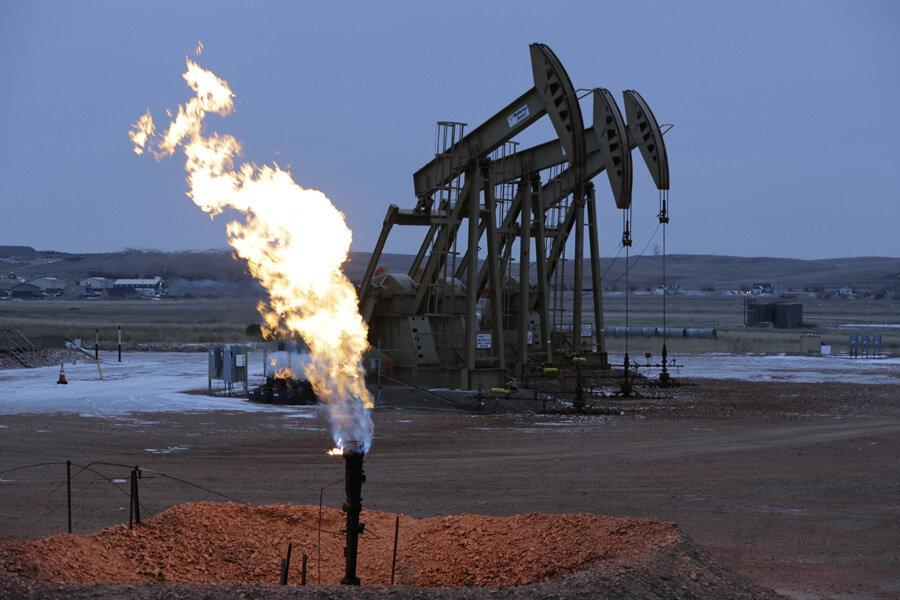EPA targets methane, that other greenhouse gas
Loading...
Carbon dioxide may be the world's most notorious planet-warming gas, but methane packs a big climate punch, too. The chemical compound, which constitutes most of the fossil fuel we call natural gas, is second only to carbon dioxide among the country's most prevalent greenhouse gases. But if you compare CH4 and CO2 on a pound-for-pound basis, methane's impact on climate change is 25 times that of carbon dioxide over a 100-year period, according the US Environmental Protection Agency (EPA).
It's little surprise, then, that the Obama administration proposed the first national rules Tuesday to limit emissions of methane from the oil and gas industry. President Obama has made curbing climate change a cornerstone of his second term, and Tuesday's rules are part of a package of new policies aimed at demonstrating that the world's second-largest emitter is serious about transitioning to cleaner energy sources. In December, representatives from nearly 200 countries will meet in Paris to complete a global agreement reduce greenhouse gas emissions and prepare for life on a warmer planet.
“Today, through our cost-effective proposed standards, we are underscoring our commitment to reducing the pollution fueling climate change and protecting public health while supporting responsible energy development, transparency and accountability,” EPA Administrator Gina McCarthy said in a statement Tuesday. “Cleaner-burning energy sources like natural gas are key compliance options for our Clean Power Plan and we are committed to ensuring safe and responsible production that supports a robust clean energy economy.”
Targeting methane emissions represents somewhat of a tightrope walk for the Obama administration, which has largely championed the country's natural gas boom and it's contribution to lowering carbon dioxide emissions. Already, oil and gas representatives are pushing back against the rules, saying they disregard the industry's progress on emissions and threaten to slow the country's rising energy influence. Environmental groups have largely praised the effort, but say it focuses too narrowly on new sources of emissions without properly addressing existing infrastructure.
The proposed rules require that oil and gas firms find and repair natural gas leaks throughout the oil and gas production and transportation chain. They also require that energy firms capture associated methane emissions from hydraulically fractured oil wells and limit emissions from equipment used in the storing and transporting of natural gas.
By 2025, the rules would reduce 340,000 to 400,000 short tons of methane, according to EPA. That's roughly the same as reducing 7.7 million to 9 million metric tons of carbon dioxide. EPA projects the benefits of reducing methane and related emissions will total between $460 million and $550 million by 2025, outweighing the expected costs of between $320 million and $420 million.
Overall, the administration has pledged to reduce methane emissions from the oil and gas sector by 40 to 45 percent from 2012 levels by 2025. Tuesday's rules would get the industry to 20 to 30 percent below 2012 levels by 2025, Janet McCabe, acting assistant administrator for EPA's Office of Air and Radiation, said in a press call Tuesday. That begs the question: how will the administration achieve the remaining emissions reductions it has pledged?
"As we move forward, additional opportunities will be identified to get to that goal," Ms. McCabe said during Tuesday's call, responding to repeated questions on the topic. "That doesn’t mean we have every one of them identified at this moment."
For some, Tuesday's rules are only a first step on a path toward more comprehensive methane regulations.
“Setting the first national standards for methane emissions from the oil and gas industry is an important move, but it can’t be the last," Fred Krupp, president of Environmental Defense Fund, said in a statement Tuesday. "This proposal addresses methane emissions from newly built and modified oil and gas operations, but not from the existing facilities that account for all of today's emissions and will still account for 90 percent of the problem by 2018."
Indeed, one of biggest challenges in curtailing methane emissions is ensuring they are accurately recorded. Leaks can occur across the vast, intricate network of drilling sites, compressor stations, pipelines, storage tanks, and home appliances that make up the country's oil and gas system. Some have identified potential issues with the equipment used to monitor methane emissions. The same day EPA released its rules, a study published in the journal Environmental Science and Technology said natural gas gathering facilities lose up to 8 times as much natural gas as the EPA estimates.
Still, most evidence suggests the oil and gas industry has made significant overall progress toward reducing both carbon dioxide and methane emissions. By EPA's own measure, methane emissions in the US decreased by almost 15 percent between 1990 and 2013 as industry implemented voluntary measures to repair leaks and capture emissions. After all, there's an economic incentive for companies to prevent methane loss, since it can often be sold as a fuel for power plants, automobiles, and other applications. It's largely why oil and gas firms are opposed to the EPA's new proposal, which they call costly and unnecessary.
“The oil and gas industry is leading the charge in reducing methane,” Jack Gerard, chief executive of the American Petroleum Institute, an industry group, said in a statement Tuesday. “The last thing we need is more duplicative and costly regulation that could increase the cost of energy for Americans."






